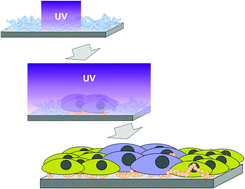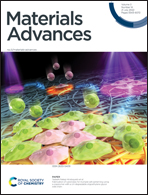Fabrication of substrates for multiple cell patterning using a copolymer with a UV-degradable oligoethylene glycol side chain†
Abstract
A random copolymer of ω-methoxy-(ethylene glycol)8 acrylamide (MEGAm) and 3-methacryloxypropyltrimethoxysilane (MPTMS) was prepared by free radical polymerization, and glass substrates were modified with the copolymer by silane coupling. MEGAm is a bio-inactive material because of its oligoethylene glycol chain, which can be cleaved by UV irradiation. Therefore, the amount of protein adsorption and cell adhesion to the copolymer-modified glass substrate increased after UV irradiation. Furthermore, when a part of the copolymer-modified glass substrate was subjected to UV irradiation and cells were seeded on the substrate, the cells adhered selectively to the UV-irradiated part. The subsequent UV-irradiation of the other part containing the area where cells adhered caused another kind of cell to adhere to the latter part of the substrate. Thus, we could achieve multiple cell patterning.



 Please wait while we load your content...
Please wait while we load your content...